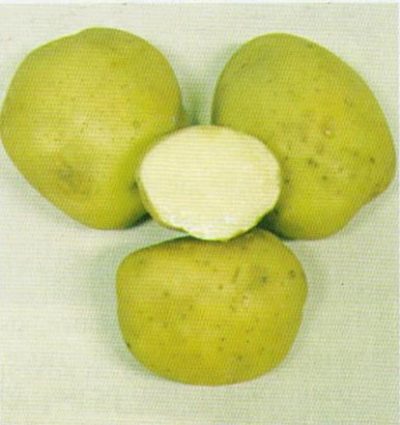
- Authors: Osipova E.A., Zueva O.I., Tsar'kov N.I., Evdokimova Z.Z. Pelli A.A., Bryantseva E.V.
- Year of approval: 1996
- Appointment: dining room
- Tuber weight, g: 83-143
- Peel color: white
- Color of the pulp: white
- Starch content,%: 12,0-18,4%
- Tuber shape: rounded
- Peel structure: smooth
- Eyes: unpainted
Potatoes Elizabeth is an old variety that is appreciated among domestic gardeners. The culture attracts with high yields and dazzling white pulp of tubers. In addition, potatoes are resistant to various diseases and pests.
Breeding history
Domestic breeders were engaged in the breeding of potatoes Elizabeth. The variety got into the state register in 1996 after successfully passing the necessary tests.
Description of the variety
The Elizaveta variety is in demand in many regions of the country. Main characteristics:
- bushes - erect;
- leaves are medium, dark green in color, with black veins and wavy edges;
- inflorescences are small and weak.
The plant produces a minimum of buds that fall off immediately.
Characteristics of the appearance of the bush and root crops
Potato bushes are leafy, so they look quite compact. The variety attracts gardeners with light-colored tubers with smooth skin. The eyes that each root vegetable has are small. If we look at the cut potatoes, then the color of the flesh will be bright white. The peculiarity is that it does not darken over time when in contact with air.
Purpose and taste of tubers
The variety has an excellent taste. Its purpose is a dining room. The pluses of root crops include a pleasant consistency and good keeping quality.
Maturation
The bush forms the first roots in 60–80 days after planting. You can dig up potatoes for the first sample already 55 days after planting.
Yield
A competent approach to care will provide a yield of 290-400 c / ha. The whole of one root crop will be 83-143 g.
Growing regions
Elizabeth potatoes are in demand for planting in regions such as:
- Northern;
- North Caucasian;
- Volgo-Vyatsky;
- Central.
Also, the variety is planted in the Far East. The plant tolerates cool weather well, which makes it possible to grow even in harsh conditions.
Growing and caring
You can increase the yield of potatoes only by the right approach to planting and growing crops. Recommendations for choosing a location:
- flat and open areas;
- deep bedding of groundwater;
- fertilized soil.
If groundwater is located nearby, drainage must be provided. Fertilizers need to be applied in the spring just before planting, during the periods of budding and flowering. The material for planting is prepared in the fall, and in the spring, a couple of weeks before the tubers are moved to the ground, they are sorted, placed in a box and placed in a dry warm place for tubers to germinate.
The optimum storage temperature for root crops is 12– ° C. In addition, gardeners recommend processing potatoes to enhance immunity and for prevention.
The timing of planting potatoes Elizabeth is determined by the climatic conditions of the region. Usually, planting begins when the soil warms up to a temperature of 10 ° C. During planting, it is recommended to maintain a distance of 35 cm between holes, as well as 70 cm between rows. After planting the potatoes, care must be taken.
- Watering.The variety is distinguished by an increased love of moisture, so it must be watered at least 3 times per season. The first watering is applied when the bush sprouts 20 cm, the second time the potatoes are watered abundantly during flowering. Moisture is added for the third time at the end of flowering. Gardeners are advised to stop watering 2 weeks before harvesting so that the roots do not rot.
- Top dressing. The first fertilizers are applied even before planting potatoes, using organic compounds. The rest of the dressing is recommended to be combined with watering. Mineral formulations are suitable as fertilizers.
- Hilling and weeding. After each watering or rain, the soil must be thoroughly loosened to provide the potato roots with the necessary amount of oxygen. It is also recommended to regularly weed the area to remove weeds. Finally, caring for potatoes involves hilling the crop. The first time the procedure is carried out when the bush rises 20 cm above the ground. The second hilling is performed after 2 weeks, the third time - after 4 weeks.
Timely care is the key to obtaining a high-quality and tasty harvest.

Planting potatoes is one of the main spring activities traditional for Russian gardeners. There are many ways to plant this vegetable, allowing you to get a good harvest in different conditions and climates. Before planting, you need to carefully prepare the planting material, correctly determine the timing, competently prepare the soil.


Soil requirements
When choosing a place for planting potatoes Elizabeth, preference should be given to loams or sands. Before planting, it is recommended to dig up the soil in both autumn and spring, additionally adding organic fertilizers to the soil.

Disease and pest resistance
The variety is characterized by excellent immunity, so potatoes are able to withstand popular diseases and pests. However, the plant is quite sensitive:
- to late blight;
- macrosporiosis;
- to Colorado beetles;
- aphids;
- potato moth.
In addition, the cultivar can attack thrips if not cared for properly. You can cope with unpleasant neighbors and diseases through preventive treatment. The affected areas should be trimmed and burned.

Potatoes are a popular vegetable crop that many gardeners planted on their site. But growing a bountiful harvest of tasty and large tubers is unlikely to succeed if the beds are not properly protected from the most common diseases and pests. Often, the development of diseases of various etiologies of potatoes goes unnoticed, so it is important to identify the problem in time and eliminate it.
















































































